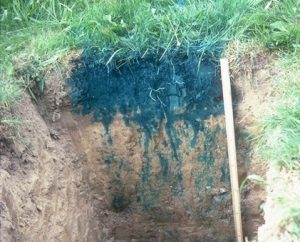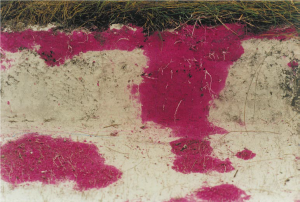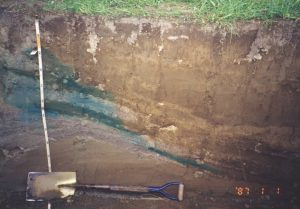9.2 Preferential Flow
Preferential flow is the uneven movement of water and solutes through a relatively small portion of the soil volume at relatively high flow rates allowing these substances to reach greater depth in shorter time than would be possible in a uniform flow situation. Multiple factors can trigger preferential flow, and its effects on solute transport can be dramatic. Consider for example the preferential flow paths observed in a well-structured soil from New York (Fig. 9‑3). The blue dye applied with the infiltrating water moved relatively uniformly through the topsoil, but upon reaching the subsoil, the dye was channeled almost exclusively through macropore flow paths. Macropores are ubiquitous and can be formed by burrowing animals such as earthworms or gophers, by the growth and decay of plant roots, and by soil shrinkage cracks. Macropore flow is one of the most common types of preferential flow, but is certainly not the only type.

In addition to macropores, other causes of preferential flow include hydrophobic soil and certain types of soil layering. A soil is considered hydrophobic when its contact angle (recall Fig. 3‑10) with water is >90°. Hydrophobic conditions can arise in surface or subsurface layers where the organic matter content is high or where the soil minerals have extensive organic coatings. Soil hydrophobicity is often observed in places where the soil surface receives substantial inputs of plant residues, such as on the forest floor or even on the greens of golf courses. Water and solutes do not readily enter a hydrophobic layer, rather they tend to accumulate above the hydrophobic layer until reaching a critical point. At that point the hydrophobicity is overcome in one or more distinct locations, and the water and solutes flow preferentially through this small, newly-wetted portion of the layer.
Figure 9-4 shows a clear example of preferential flow caused by hydrophobic soil. In this photograph of a sand dune with grass cover in the Netherlands, the wetting pattern after natural rainfall is highlighted by red dye [3]. The hydrophobic surface layer resulted in downward flow through small portions of the soil leaving much of the soil dry and increasing the total penetration depth of the wetting event. The prediction of solute transport in situations like this is further complicated by the fact that hydrophobicity can be transient. Some soils are strongly hydrophobic when dry but transition to a hydrophilic state when wetted.

Soil layering can also contribute to preferential flow, especially when a finer-textured layer has a sharp interface with a substantially coarser-textured layer. If the interface between the layers is sloping, rather than horizontal, the flow may be “funneled” in the downslope direction (Fig. 9‑5). The water does not readily pass through the coarser-textured layer because the smaller pores in the overlying finer-textured layer hold water at a more negative pressure potential than the larger pores in the coarser layer. If the interface between the layers is horizontal, then “finger” flow may develop in which water and solutes penetrate the coarser-layer only in fingers which occupy a small portion of the total volume. In either case, solutes can be transported to greater depths than they would otherwise, and reliably sampling of soil or groundwater to detect pollution becomes more difficult because of the extreme heterogeneity in the flow paths.


